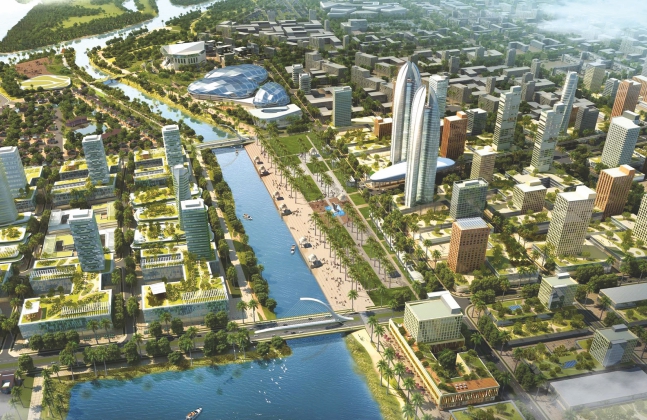Having notched the third position in the national logistics index within just four years of formation, the sunrise state is now chasing a larger vision to be among the top 15 states in the Global Competitiveness Index
Can anyone expect a newly formed state in a country to post a growth rate which is much higher than the country itself? Well, the sunrise state of Andhra Pradesh has achieved this remarkable feat under the visionary leadership of Chief Minister Chandrababu Naidu. The government has set a target of achieving 15 per cent CAGR in the years to come. Andhra Pradesh succeeded in achieving the double-digit growth rate from 8.51 per cent in 2014-15 to 11.37 per cent during the first half of the current fiscal, 2017-18. “Compared with the national growth rate of 5.8 per cent, A.P.’s growth rate is very impressive. But a lot has to be done, as the CAGR is still hovering over 12 per cent. We need to improve it and a lot needs to be done in the industry and services sectors,” says N Chandrababu Naidu, Chief Minister of the state.
Following the bifurcation in 2014 the state was left in a very challeng- ing situation with revenue and power deficit. But within three to four years of formation the state has catapult to number one position on various fronts – ease of doing business, attracting private sector investments, infrastructure reforms and e-governance and technology initiatives. Andhra Pradesh is today the fastest growing state in India with 10.99 per cent GSDP growth rate in FY2015-16. Andhra Pradesh is the first state to introduce single window clearance. The government departments ensure to award all clearances within 21 days for any investment proposal through a single window.
The state government has a vision to grow at 10-15 per cent every year till 2029, in terms of GDP and the per capita GDP has to reach $12,000- 15,000 in this time frame. Since 2014 the state has already clocked double digit growth twice and is well on track to achieve this GDP growth.
The government has framed a vision that aims at:
- Positioning AP among the top three developed states by 2022
- Raise the GSDP to $946 billion by 2029
- Accelerate economic growth rate to 12 per cent by 2029
- To become a leading global investment destination by 2050
Industrial development
Out of the five industrial corridors proposed by the Indian government, two corridors pass through the state. The phase I of east coast corridor will be from Vizag to Chennai. The second corridor is from Chennai to Bengaluru. Development along these corridors is going to happen in a cluster based approach.
The Vizag-Chennai Industrial Corridor (VCIC) is 800-km long dedicated fright corridor passing along the NH-16 and along the Bay of Bengal in Tamil Nadu and AP. VCIC is one of the key components of the East Coast Economic Corridor (ECIC) being developed between Kolkata and Tuticorin. The 800 km long project is divided into nine nodes including two at Nakkapalli and Atchutapuram in Visakhapatnam district, Kakinada in East Godavari district, Machilipatnam in Krishna district and Prakasam along the east coast. The government ensures that proper ecosystem is provided for these industrial clusters to prosper, also offering immense opportunity for logistics players to provide end-to-end solution.
The Naidupeta cluster in Nellore district is the first major component of VCIC. Having close proximity to Krishnapatnam Port the cluster will have good rail connectivity. Spread on nearly 4,200 acres the cluster will see sizeable investment from power, automobile and bulk drugs sectors.
Automobiles, electronic manufacturing, plastics, food processing, textiles and apparels, chemicals, pharmacy and pharmaceuticals are some of the key sectors to be given priority for development along VCIC with the objective of attracting minimum `1 lakh crore investment in a year.
In addition, Vijayawada is growing in all directions with software companies setting up in the south at Mangalagiri in Guntur district, tourism industry is being developed in west at Ibrahimpatnam in Krishna district, education institutions and realty, infrastructure projects are coming up in east direction at Kankipadu-Machilipatnam stretch and automobile companies are growing in Hanuman Junction – Gannavaram stretch. Mangalagiri town is being developed as an IT hub in Amaravati.
A Korean industrial hub is coming up near Krishnapatnam Port, wherein KIA Motors will be the anchor industry along with other automotive ancillary industries. APEDB has inked MoU with Tier-2 and Tier-3 ancillaries of KIA Motors. The first exclusive mobile and electronic manufacturing cluster in India will be coming up in Amaravati. Three major Indian mobile manufacturers – Celkon, Karbonn and Lava will establish units in the EMC. Chief Minister N Chandrababu Naidu has allotted 113.27 acres of land for the new cluster. A MSME cluster is coming up near Amaravati that will specialise in aerospace components, machine spares and home appliances.
The Chennai Bengaluru Industrial Corridor passes through Krishnapatnam where a full-fledged industrial township spread over 50 sq. kms will be established. This is the first coastal Japanese industrial township in India.
The Kurnool Bengaluru industrial corridor will see development at the Orvakal node. In addition, eight mega food processing parks will come up in Srikakulam, Vizianagaram, Visakhapatnam and East Godavari and Chittoor, Kurnool and Anantapur districts. Further a CEZ is being developed in Krishnapatnam with focus on electronics, while the CEZ in Vizag and Kakinada will have petrochemical, food processing, cement and apparel based industries.
Visakhapatnam, Kakinada, Krishnapatnam, Hindupur, Srikalahasti- Yerpedu, and Gannavaram-Kankipadu are the nodes in the industrial corridors where major industrial hubs will come up. As a result, the GDP in corridor districts will increase by 6 times upto $161.5 billion by 2035. Manufacturing output will expand by seven times to $115 billion and an incremental employment for 14 million people will be created by 2035.
Pharma clusters
A new pharma city is being developed at Achutapuram in Visakhapatnam. An exclusive cluster for veterinary and biopharma will come up at Pulivendala in Kadapa. A biopharma fermentation cluster will be developed at Nellore and an integrated biocity will be established in Ananthapur. These locations offer the perfect opportunity for setting of temperature controlled warehouses.
Textile zones
Having a legacy of handlooms and handicrafts production, it is no surprise that Andhra Pradesh is the second largest producer of cotton and raw silk. A unique integrated apparel city ‘Brandix’ is being developed in Visakhapatnam, with an innovative ‘Fibre to Store’ concept. Further the state has a strong presence of textilebased industries in Guntur, Chittoor, Kadapa, and Kurnool. Other potential textile production zones in the state include Donnagondam in Guntur, CS Puram and Pedaganjam in Prakasam and Anantapur. As the textile industry expands there will be huge demand for warehousing and logistics service providers as well.
Mega food parks
Each district in the state will have one food processing park. There are four food parks already existing and nine more will be established. Krishna mega food park is coming up at Agiripalli and this will be a multi-product food park. Spice processing and export units will be at spice park in Guntur. Godavari Aqua Mega Food Park will be located at Bhimavaram and will undertake aqua produce processing. Srini food park in Chittoor is another multi product food park. An ultra mega food park will come in Kurnool.
Ease of doing business
To ensure industrial development is fast tracked, the government has initiated several measures to ensure ease of doing business:
- A single desk policy is being implemented wherein all clearances required for setting up an industry will be issued within 21 days
- Deemed approval will be issued based on self-certification
- Inspections are assigned to private technical experts
- Processing for multiple clearances will be done simultaneously
- All the applicable acts, rules and policies of respective competent authorities will be reviewed for speedy clearance
- Strengthening capacity of respective competent authorities and district industry centres
- Operations of competent authorities and nodal agencies will be streamlined and tracked Logistics infrastructure With industrial clusters cropping across the length and breadth of the state, swift cargo movement will be order of the day and requires massive
logistics infrastructure. The state has a well-established transport infrastructure with a million plus acres of land bank, enabling a conducive ecosystem for industrial growth. Blessed with the second largest coastline in the country, the state has six operational seaports with an existing capacity of 180 mmt and about 120 mmt of traffic handled. The state has proposed to set up eight more seaports. Direct shipping calls from South East Asian economies to AP ports vis-à-vis ports on west coast will save transit time of around 2-3 days
The state has 6 airports and further six airports are proposed to be developed, which include the mega aerotropolis coming up in Bhogapuram on 2,200 hectares of land that will act as India’s gateway to Asia Pacific region. To ensure seamless movement of cargo to industrial hubs a road network of 1,23,334 km (4,302 km – NHs), 2,660 km of rail network and 888 km of National Waterways have been developed. To promote tourism industry a beach road from Ichchapuram to Tada is being developed. Beach corridors are being developed from Bhogapuram to Bheemli and from Vizag to Addaripeta.
Inland waterways
A huge potential for Inland Water Transport exists with National Waterway 4 passing through the state. Of the 1,095 km of the waterway that stretches from Kakinada to Puducherry, 888 kms lie in Andhra Pradesh. 27 locations have been identified by RITES as prioritized terminals under water transportation grid. The estimated cargo traffic moving through the waterways is projected to be about 5 MT by 2019, 10 MT by 2029, and 20 MT by 2059.
Truck terminals
Considering the fact that road still remains the preferred mode of moving cargo, Guntur, Tada, Ichchapuram and Jagayyapet have been identified as potential locations for developing truck terminals. Each terminal will be spread on about 50-100 acres. Having occupied the third notch behind Gujarat and Punjab in the recently released logistics performance index by the Ministry of Commerce and Industry, the state’s leadership is now chasing a much larger vision to number among the top 15 states in the Global Competitiveness Index by 2050.









